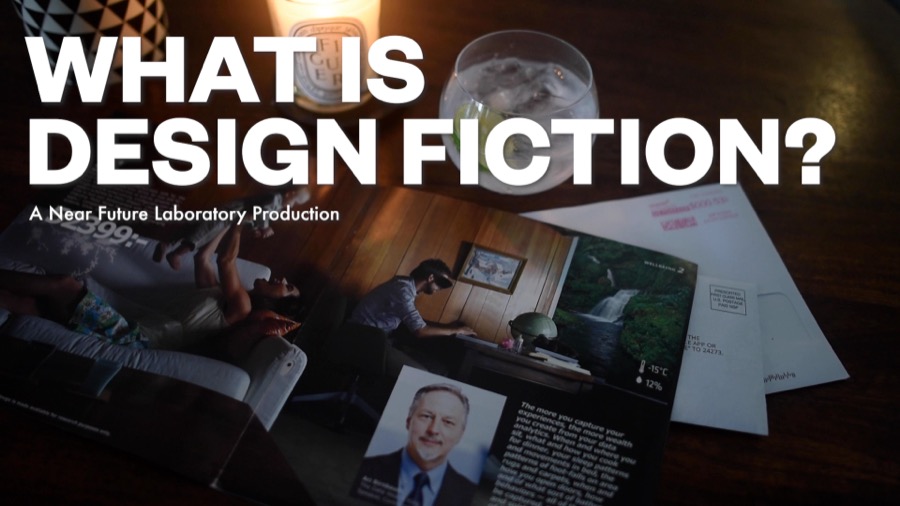
Design fiction is the practice of creating tangible and evocative prototypes from possible near futures to help discover and represent the consequences of decision making. That’s the serious definition, but what does that actually mean? Where did it come from? What does it look like? And who uses it?
Let’s start with its origin. This is Bruce Sterling, science fiction writer, cyberpunk creator, and all round futurist. And this is Julian Bleecker, an engineer, designer, and co founder of the Near Future Laboratory. They met in Los Angeles in 2005, while Julian was a professor at the film school at USC, and Bruce was visionary in residence at Art Center College of Design.
Over the course of their many conversations, Julian wondered to Bruce if design and science fiction could work together somehow to tell stories through fictional objects. To that Bruce said, Sure, call it design fiction. Stories about possible worlds that are told through designed artifacts. So that’s what kicked the whole design fiction thing off.
But what’s it actually for? Well, when it comes to thinking about futures, people tend to have a hard time. It turns out that our imaginations just aren’t that good. People get trapped in little loops of thinking, so futuristic stuff starts to look and feel the same. People have a habit of talking in very vague terms.
They reference the last tech article they read, or the last sci fi film they saw. They produce images and videos of mind boggling new tech, utopian landscapes and magical moments. Alternatively, they rush to the other end of the spectrum and show us dystopian ruins. Societal collapse and endless disaster.
It all starts to feel a bit like fantasy rather than anything actually useful. Statistics, predictions and trends are only so useful too. That dotted line might go up and to the right. What does that really mean? And for whom? I don’t know. That Gartner Hype Cycle roller coaster doesn’t show us what all those trends may actually look like if they come to pass.
How might lives actually change, and how might they stay the same? So what else could we do? Let’s think about archaeologists for a second. They dig around in the dirt and discover a bit of pottery, a broken spoon, or a few trinkets, and then set about building a whole narrative around their subjects.
Little hints of evidence help them understand details about those ancient lives. How their society worked, what was important, who was in charge, and how they struggled or prospered. Little glimpses of everyday lives betray significant stories if you just look hard enough. In simple terms, design fiction is like archaeology for the future.
It captures potentially huge or inspiring shifts in technology, society, or politics in well known, ordinary, mundane things. Here’s something else to think about. Futures don’t just happen in isolation. They happen all together. Imagine if tomorrow’s archaeologists found a box of today’s breakfast cereal.
Sure, it would tell them what we ate, but it would also tell them where things were made, where they were sold, how they were sold, the technologies we had access to, how our government worked, what was important in our society. What we cared about in our culture, and much, much more. Design fiction takes an ordinary thing, like a box of cereal, and uses it as a canvas to visualize insights, research, and trends as if they had actually happened.
Bringing them together like this lets us experience these changes in ways that a chart never could, and forces us to embrace the details in ways that a concept video never would. A design fiction prototype allows for the abstract to become real for a moment. It helps focus the conversation in a grounded way.
It breaks down abstractions and asks a group of people to think in detail about where the future might be headed and how we’ll all experience it. Design fiction aims to capture the full context of our future so that we can feel like we’re really living in it.
Design fiction isn’t focused on the movie star. It’s interested in the production design in the corner of the frame. Design Fiction isn’t obsessed with the latest glossy device, it wants to know what’s written in the little terms and conditions slip. Design Fiction doesn’t want to script that bombastic launch event, it’s more curious about the inevitable customer service call.
Some of the world’s largest companies, organisations and governments now use Design Fiction as a way to dive deeper into the future, with the hope of creating more realistic, engaging and rigorous visions. Over the last 15 years, design fiction has grown to become a powerful tool in developing ideas, becoming instrumental in shaping the thinking of teams of designers, technologists, engineers, strategists and futurists.
So that’s design fiction, the practice of creating tangible and evocative prototypes from possible near futures to help discover and represent the consequences of decision making. There’s much more to discuss, but we hope this has given you a taste.